#or atmospheric science
Explore tagged Tumblr posts
Text
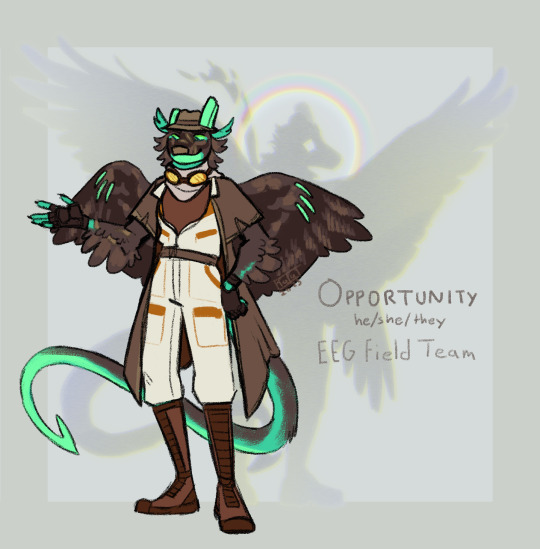
i’ve posted this set of guys together in a lineup but i never got around to sharing more about them individually, so i’m gonna do that!
Tune here is an original member of the EEG, one of the first researchers approached by Sojourner and Pathfinder, the founders, back when the whole operation was just some barely funded passion project, and the properties of the Otherworld were poorly understood. She was a team leader for decades up until he met a tragic demise on what should have been a routine mission. He’s since been declared M.I.A. (in truth she Stayed Alive Wrong)
-> Tune and Odyssey were queerplatonic partners. They met each other in their school years and hit it off quickly. They signed on with the project as a package deal and for years they were a team of two and both set out for field research and exploration, but following an Incident that injured them both, Odyssey left the field for a different role and the various teams were consolidated into one unit for safety reasons. As a precaution, future expeditions would need at least three active participants.
-> Tune was very confident and self-assured, and naturally fell into a leadership role within the new system. He had a knack for assessing and utilizing the strengths of her teammates and encouraging teamwork and communication.
-> In the early days they were quite cocky and perhaps a bit too reckless, but the decades of her employment with the EEG mellowed her out somewhat. What really drew her to the initial job offer was the thrill of adventuring in uncharted lands full of unknown dangers.
-> In general, Opportunity tended to prioritize the pursuit of knowledge above his own safety, though being in charge of a team who depended on her for their own well-being helped to balance out this impulse.
-> In that early incident, Tune received a concussion that had lasting effects in the form of frequent migraines and insomnia. She wasn’t very vocal about her struggles, and he was more inclined to push through the pain than slow down and wait for it to pass.
-> Age didn’t temper her active lifestyle, either. As she neared her 50s they were still up to shit like free climbing vertical cliffs to get a good vantage point (and for the fun of it).
-> She was up to just that, on a mission with her sibling Spirit and friend Curiosity when a terrible, unnatural storm hit without warning. The Otherworld had always been a turbulent place, the landscape and climate always changing, but the team’s experience and technology should have been enough to sense the shift coming, but it caught them unawares.
-> Tune and his two teammates lost contact with mission control and each other for more than an hour. When the storm cleared, Curiosity and Spirit and the two constructs accompanying them were all recovered, but no trace of Opportunity could be found. Reluctantly, the team came to the decision to abandon the search.
-> Opportunity still exists, in some form. They haven’t had a run in with her old team in the few years since her disappearance. Mentally she’s not all there, retaining only their instincts and basic desires. He’s generally passive, but whatever the storm did to him left them with a connection to the shifting terrain of the Otherworld, which responds to their presence and volatile feelings. She’s usually surrounded by a storm like the one that changed her. He wants to be found, but… if she encountered and recognized her team, it’s likely he would seek to drive them out with force in a misguided attempt to protect them from the Otherworld’s many hazards.
#my art#my characters#alt text#image#set: eeg#flight rising#flight rising art#kind of. they’re pretty detached from FR but i like the designs too much to fully remove them#char: opportunity#yes she’s inspired by the opportunity rover#also by the song orpheus - minimall. that propelled this whole story#everybody on the team are named after mars probes#he’s haunting the narrative#not alive not dead but some secret third thing#i don’t think i ever actually pinned down her scientific specialty. maybe something with geology#or atmospheric science#i like that one actually i think it’s atmospheric science#his altered form is based on brocken spectres#i’m sleep deprived so if anything here is incoherent pretend it’s not 🫶
38 notes
·
View notes
Text




Alien (1979)
#alien movie#scifi#movies#scifiedit#science fiction#nostromo#spaceship#spacecraft#atmospheric#scifi aesthetic#space ship#gifs#gifset#space shuttle#outer space#space#space exploration#ridley scott#planets
3K notes
·
View notes
Text
As relentless rains pounded LA, the city’s “sponge” infrastructure helped gather 8.6 billion gallons of water—enough to sustain over 100,000 households for a year.
Earlier this month, the future fell on Los Angeles. A long band of moisture in the sky, known as an atmospheric river, dumped 9 inches of rain on the city over three days—over half of what the city typically gets in a year. It’s the kind of extreme rainfall that’ll get ever more extreme as the planet warms.
The city’s water managers, though, were ready and waiting. Like other urban areas around the world, in recent years LA has been transforming into a “sponge city,” replacing impermeable surfaces, like concrete, with permeable ones, like dirt and plants. It has also built out “spreading grounds,” where water accumulates and soaks into the earth.
With traditional dams and all that newfangled spongy infrastructure, between February 4 and 7 the metropolis captured 8.6 billion gallons of stormwater, enough to provide water to 106,000 households for a year. For the rainy season in total, LA has accumulated 14.7 billion gallons.
Long reliant on snowmelt and river water piped in from afar, LA is on a quest to produce as much water as it can locally. “There's going to be a lot more rain and a lot less snow, which is going to alter the way we capture snowmelt and the aqueduct water,” says Art Castro, manager of watershed management at the Los Angeles Department of Water and Power. “Dams and spreading grounds are the workhorses of local stormwater capture for either flood protection or water supply.”
Centuries of urban-planning dogma dictates using gutters, sewers, and other infrastructure to funnel rainwater out of a metropolis as quickly as possible to prevent flooding. Given the increasingly catastrophic urban flooding seen around the world, though, that clearly isn’t working anymore, so now planners are finding clever ways to capture stormwater, treating it as an asset instead of a liability. “The problem of urban hydrology is caused by a thousand small cuts,” says Michael Kiparsky, director of the Wheeler Water Institute at UC Berkeley. “No one driveway or roof in and of itself causes massive alteration of the hydrologic cycle. But combine millions of them in one area and it does. Maybe we can solve that problem with a thousand Band-Aids.”
Or in this case, sponges. The trick to making a city more absorbent is to add more gardens and other green spaces that allow water to percolate into underlying aquifers—porous subterranean materials that can hold water—which a city can then draw from in times of need. Engineers are also greening up medians and roadside areas to soak up the water that’d normally rush off streets, into sewers, and eventually out to sea...
To exploit all that free water falling from the sky, the LADWP has carved out big patches of brown in the concrete jungle. Stormwater is piped into these spreading grounds and accumulates in dirt basins. That allows it to slowly soak into the underlying aquifer, which acts as a sort of natural underground tank that can hold 28 billion gallons of water.
During a storm, the city is also gathering water in dams, some of which it diverts into the spreading grounds. “After the storm comes by, and it's a bright sunny day, you’ll still see water being released into a channel and diverted into the spreading grounds,” says Castro. That way, water moves from a reservoir where it’s exposed to sunlight and evaporation, into an aquifer where it’s banked safely underground.
On a smaller scale, LADWP has been experimenting with turning parks into mini spreading grounds, diverting stormwater there to soak into subterranean cisterns or chambers. It’s also deploying green spaces along roadways, which have the additional benefit of mitigating flooding in a neighborhood: The less concrete and the more dirt and plants, the more the built environment can soak up stormwater like the actual environment naturally does.
As an added benefit, deploying more of these green spaces, along with urban gardens, improves the mental health of residents. Plants here also “sweat,” cooling the area and beating back the urban heat island effect—the tendency for concrete to absorb solar energy and slowly release it at night. By reducing summer temperatures, you improve the physical health of residents. “The more trees, the more shade, the less heat island effect,” says Castro. “Sometimes when it’s 90 degrees in the middle of summer, it could get up to 110 underneath a bus stop.”
LA’s far from alone in going spongy. Pittsburgh is also deploying more rain gardens, and where they absolutely must have a hard surface—sidewalks, parking lots, etc.—they’re using special concrete bricks that allow water to seep through. And a growing number of municipalities are scrutinizing properties and charging owners fees if they have excessive impermeable surfaces like pavement, thus incentivizing the switch to permeable surfaces like plots of native plants or urban gardens for producing more food locally.
So the old way of stormwater management isn’t just increasingly dangerous and ineffective as the planet warms and storms get more intense—it stands in the way of a more beautiful, less sweltering, more sustainable urban landscape. LA, of all places, is showing the world there’s a better way.
-via Wired, February 19, 2024
#california#los angeles#water#rainfall#extreme weather#rain#atmospheric science#meteorology#infrastructure#green infrastructure#climate change#climate action#climate resilient#climate emergency#urban#urban landscape#flooding#flood warning#natural disasters#environmental news#climate news#good news#hope#solarpunk#hopepunk#ecopunk#sustainability#urban planning#city planning#urbanism
14K notes
·
View notes
Text
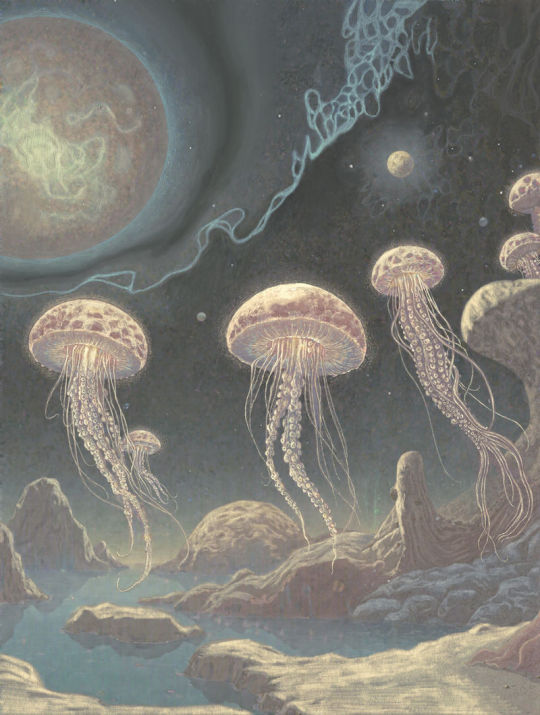
"Jellyfishes" by Ghionion.
#ghionion#atmospheric life form#sky jellyfish#alien#alien landscape#landscape#science fiction#space art
1K notes
·
View notes
Text

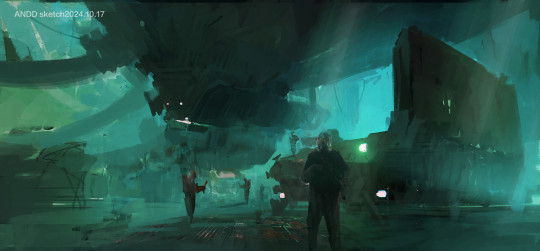



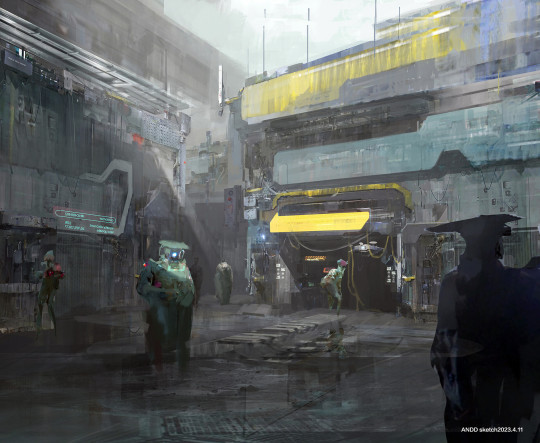


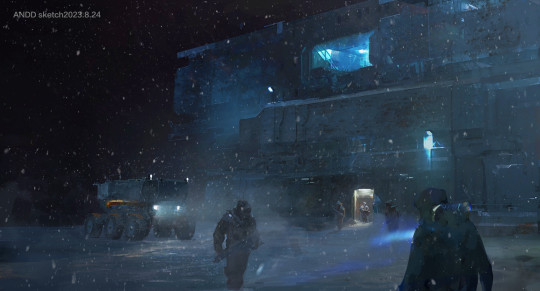



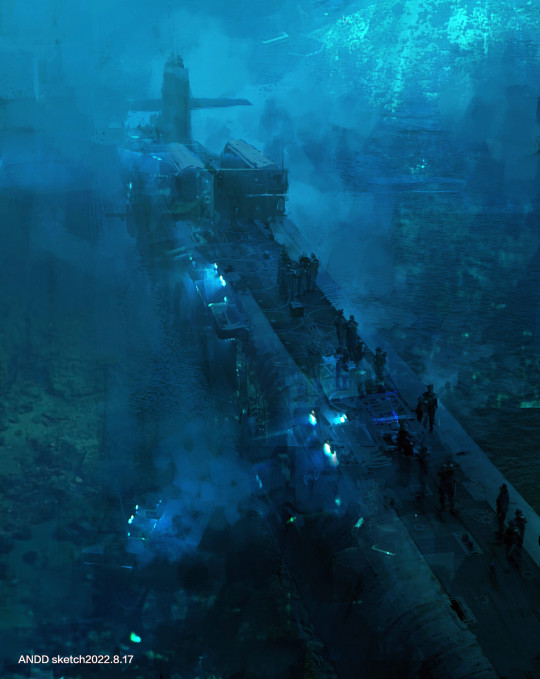

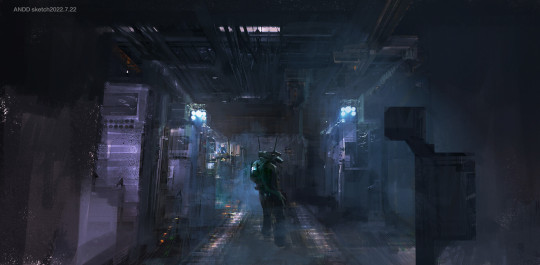

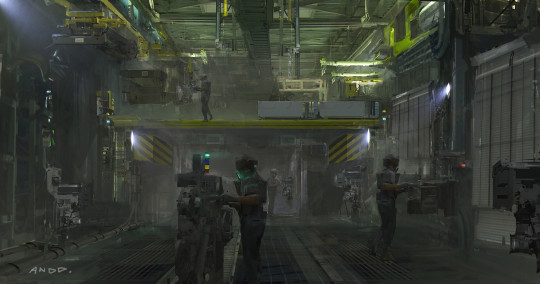
The atmospheric sci-fi-themed digital sketches and creations of Yi Liu - https://www.this-is-cool.co.uk/the-atmospheric-sci-fi-themed-sketches-of-yi-liu/
#Yi Liu#Andd2077#this-is-cool#scififantasyhorror#digital art#sci-fi art#concept art#science fiction art#concept artist#sci-fi artist#digital artist#Sci-fi Sketches#atmospheric art
279 notes
·
View notes
Text

Earth is such a beautiful planet
#astronomy#nasa#astronomers#universe#nasa photos#astrophotography#astrophysics#outer space#nasawebb#hubble space telescope#earth pics#beautiful earth#mother earth#earthlings#planet earth#earth#space exploration#space#science#james webb space telescope#space travel#solar system#i love astronomy#astronomy facts#nasaastronaut#nasa science#planetary science#planetary nebula#atmosphere#nasa picture of the day
863 notes
·
View notes
Text

Sharpening Our View of Climate Change with the Plankton, Aerosol, Cloud, ocean Ecosystem Satellite
As our planet warms, Earth’s ocean and atmosphere are changing.
Climate change has a lot of impact on the ocean, from sea level rise to marine heat waves to a loss of biodiversity. Meanwhile, greenhouse gases like carbon dioxide continue to warm our atmosphere.
NASA’s upcoming satellite, PACE, is soon to be on the case!
Set to launch on Feb. 6, 2024, the Plankton, Aerosol, Cloud, ocean Ecosystem (PACE) mission will help us better understand the complex systems driving the global changes that come with a warming climate.
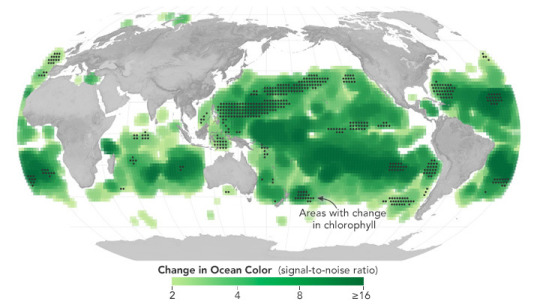
Earth’s ocean is becoming greener due to climate change. PACE will see the ocean in more hues than ever before.
While a single phytoplankton typically can’t be seen with the naked eye, communities of trillions of phytoplankton, called blooms, can be seen from space. Blooms often take on a greenish tinge due to the pigments that phytoplankton (similar to plants on land) use to make energy through photosynthesis.
In a 2023 study, scientists found that portions of the ocean had turned greener because there were more chlorophyll-carrying phytoplankton. PACE has a hyperspectral sensor, the Ocean Color Instrument (OCI), that will be able to discern subtle shifts in hue. This will allow scientists to monitor changes in phytoplankton communities and ocean health overall due to climate change.

Phytoplankton play a key role in helping the ocean absorb carbon from the atmosphere. PACE will identify different phytoplankton species from space.
With PACE, scientists will be able to tell what phytoplankton communities are present – from space! Before, this could only be done by analyzing a sample of seawater.
Telling “who’s who” in a phytoplankton bloom is key because different phytoplankton play vastly different roles in aquatic ecosystems. They can fuel the food chain and draw down carbon dioxide from the atmosphere to photosynthesize. Some phytoplankton populations capture carbon as they die and sink to the deep ocean; others release the gas back into the atmosphere as they decay near the surface.
Studying these teeny tiny critters from space will help scientists learn how and where phytoplankton are affected by climate change, and how changes in these communities may affect other creatures and ocean ecosystems.
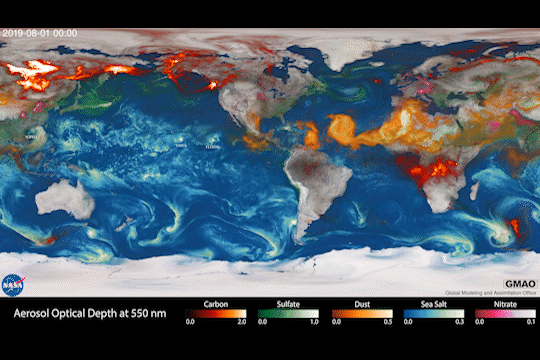
Climate models are one of our most powerful tools to understand how Earth is changing. PACE data will improve the data these models rely on.
The PACE mission will offer important insights on airborne particles of sea salt, smoke, human-made pollutants, and dust – collectively called aerosols – by observing how they interact with light.
With two instruments called polarimeters, SPEXone and HARP2, PACE will allow scientists to measure the size, composition, and abundance of these microscopic particles in our atmosphere. This information is crucial to figuring out how climate and air quality are changing.
PACE data will help scientists answer key climate questions, like how aerosols affect cloud formation or how ice clouds and liquid clouds differ.
It will also enable scientists to examine one of the trickiest components of climate change to model: how clouds and aerosols interact. Once PACE is operational, scientists can replace the estimates currently used to fill data gaps in climate models with measurements from the new satellite.

With a view of the whole planet every two days, PACE will track both microscopic organisms in the ocean and microscopic particles in the atmosphere. PACE’s unique view will help us learn more about the ways climate change is impacting our planet’s ocean and atmosphere.
Stay up to date on the NASA PACE blog, and make sure to follow us on Tumblr for your regular dose of sPACE!
1K notes
·
View notes
Text
Gigantic Jets

Stormy skies feature much more than the forked cloud-to-ground lightning we're used to seeing. This composite image shows a rare and recently-recognized type of lightning known as a gigantic jets. (Image credit: Li X.; via APOD) Read the full article
#atmospheric science#fluid dynamics#gigantic jets#lightning#meteorology#physics#plasma#science#thunderstorm
184 notes
·
View notes
Text
A severe solar storm sparked by an intense flare from the sun could reach "extreme" levels as it bombards Earth, officials with the U.S. National Oceanic and Atmospheric Administration (NOAA) warned on Thursday (Oct. 10). Scientists with NOAA's Space Weather Prediction Group (SWPC) said that a cloud of charged solar material, called a coronal mass ejection, slammed into Earth around midday, triggering a "severe" geomagnetic storm that could impact power grids and GPS and radio communications systems, as well as amplify aurora displays in regions that typically don't see them.
Continue Reading.
#Science#Space#Astronomy#Sol#Solar Storm#Solar Flares#Northern Lights#Auroras#NOAA#National Oceanic and Atmospheric Administration
134 notes
·
View notes
Photo

nasa: A stone cold look at Saturn 🗿
The giant planet gives us a look into its moody disposition. The Cassini spacecraft captured this image on Jan. 30, 2007, from a distance of 700,000 miles (1.1 million kilometers). As Saturn’s atmosphere rages with thunderous and hurricane-like storms, its majestic rings spin a tale of ancient collisions and cataclysms. A joint endeavor of NASA, @europeanspaceagency, and @agenziaspazialeitaliana, Cassini was a sophisticated robotic spacecraft sent to study Saturn and its complex system of rings and moons over the course of a decade. Lessons we took from Cassini helped in the planning of our #EuropaClipper mission, which is on its way to Jupiter and expected to arrive in April 2030. Image description: A black-and-white image of Saturn taken from a lower angle. The rings of Saturn frame the upper right portion of the planet in various widths. Details of stripes and swirls from storms can be seen along the face of the planet. The left side of the planet is encompassed in a shadow. Credit: NASA/JPL-Caltech/Space Science Institute #NASA #Space #Saturn #Rings #Storms #Atmosphere #Moody #Planet #SolarSystem #BlackAndWhite
#nasa#esa#asi#space#saturn#cassini#jpl#jpl-caltech#cal tech#space science institute#planet#rings#storm#atmosphere#solar system#astronomy#space exploration#2007#january 30
54 notes
·
View notes
Text





Alien: Romulus (2024)
#alien romulus#scifi#movies#scifiedit#science fiction#spaceship#spacecraft#atmospheric#scifi aesthetic#space ship#gifs#gifset#space shuttle#outer space#space#space exploration#80s aesthetic#ridley scott#fede alvarez#computers
1K notes
·
View notes
Text
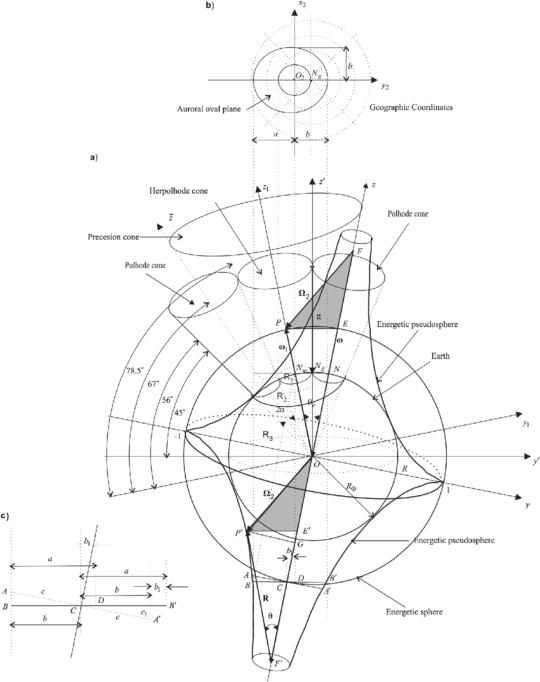
Figure A1. The shape of the aurora borealis and the regions of radiation. (a) Point O is the origin of the three coordinate systems: Oxyz, the mobile axes system of IAG, the geographic system Ox′y′z′, and the geomagnetic system Ox 1 y 1 z 1 . EP and ES with R = 1 were represented. The P′OE′ triangle is equal to PFE, and they have surfaces proportional to the negative algebraic energy generated by the absolute speed Ω 2 . On the terrestrial surface, the three types of areas with radiation and ion characteristics important for our study include the following: Region R1 at ±78.5°-90° MLAT, determined by herpolhodic cones; Region R2 at ±56°-79° MLAT, generated by the polhodic cones; and Region R3 at ±0°-56° MLAT, generated by the PCA singularities. N g was used to note the geographic North Pole and N m was used to note the magnetic North Pole and N was used to note the EP North Pole. (b) The oval shape of the aurora borealis in geographical coordinates with the origin O 2 (N m ), where a is the major semiaxis and b the minor semiaxis. Each dotted circle represents 10° of latitude. (c) The representation of the geometric situation of point C in the plane (scale 2:1). (Geophysicochemical model of an ionospheric auroral gyroscope)
35 notes
·
View notes
Text
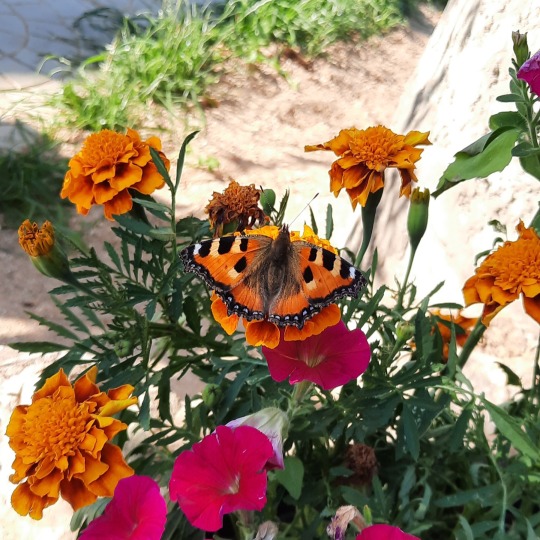
🧡The small tortoiseshell (lat. Aglais urticae, Nymphalis urticae). One of the most common species of day butterflies. It is widespread throughout Eurasia, with the exception of the far north.
With the help of their wings, butterflies transfer pollen, flying from flower to flower, thereby ranking second in the world among pollinating insects. Ahead of this rating are, of course, bees.
This species can live for about 9 months, which is considered a fairly long time in the butterfly world. The small tortoiseshells have learned to use their vital energy very economically, so they remain to winter in their native lands. At temperatures below 21 ° C, they freeze almost completely, but do not die. After surviving the winter, they reproduce, after which their life cycle ends🍃
🧡Крапивница (лат. Aglais urticae, Nymphalis urticae). Один из самых распространенных видов дневных бабочек. Распространен на всей территории Евразии, за исключением крайнего Севера.
С помощью своих крыльев бабочки переносят пыльцу, перелетая с цветка на цветок, тем самым занимая второе место в мире среди насекомых-опылителей. Впереди этого рейтинга располагаются, конечно, пчелы.
Данный вид может жить около 9 месяцев, что считается в мире бабочек достаточно большим сроком. Крапивницы научились весьма экономно использовать свою жизненную энергию, поэтому остаются зимовать в родных краях. При температуре ниже 21°C они промерзают практически полностью, но не погибают. Пережив зиму, они размножаются, после чего их жизненный цикл заканчивается🍃
#noseysilverfox#photography#nature#butterfly#science#insects#summer#autumn#original photography blog#original photography on tumblr#wildlife photography#random facts#interesting#naturecore#atmospheric#love nature#love life#photoblog#animal photography#фотографии природы#турумбочка#интересные факты#природа#фотоблог#бабочка#насекомые#дикая природа#лето#осень#фотографии на тумблере
130 notes
·
View notes
Text
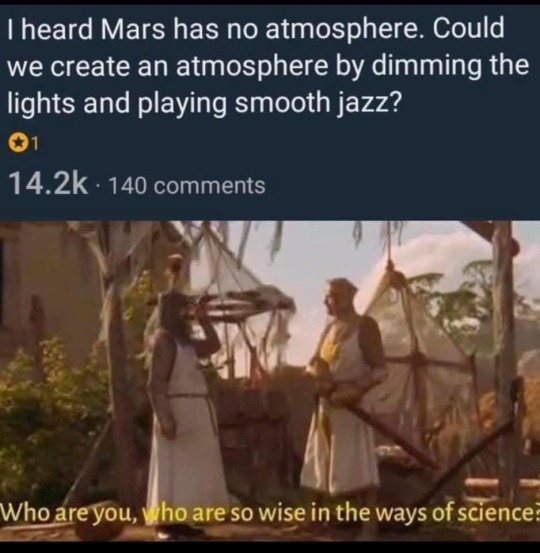
59 notes
·
View notes
Text
transcript:
JF: (yelling) ladies and gentlemen, we wanna thank you all for coming out to our first show of TODAY! [audience cheering] please come back, to our second show of today! and we'll perform an entirely different set of highly adult material!
#I love flansburgh's rock guy voice lmao#I gave up at the end there tho sorry <3 I can hear ''atmosphere''. ''you don't wanna stay up all night atmosphere''?#tell me and I'll edit it in#tmbg#they might be giants#john flansburgh#2000s#here comes science#concerts#videos
38 notes
·
View notes
Text

Starship Flight 7 BROKE up during re-entry
#ive starship#stars#space x#starship#reentry#atmosphere#astronomy#nasa#astronomers#universe#nasa photos#astrophotography#outer space#astrophysics#nasawebb#hubble space telescope#musk#elon musk#space exploration#space#science#james webb space telescope#space travel#nasa science#science facts#planetary science#our universe#the universe#planetary nebula#solar system
291 notes
·
View notes